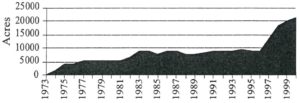For the past year, Santa Barbara County residents, their elected representatives, and County planning staff have been faced with the issue of a rapidly expanding wine-grape industry and effects of associated agricultural expansion on native oaks and other natural resources.
The concern began in the County’s rural Los Alamos Valley, where over 800 native oaks were removed for a new vineyard. Because the removal operation was highly visible from Highway 101 and many of the trees were mature valley oaks, public concern over the removal was brought before the County Board of Supervisors that same month. When it was established that the clearing was within the rights of the landowner under County regulations, the Board directed Planning & Development Department staff to develop some options that may afford better protection for the County’s rural oak woodlands.
Agriculture is Santa Barbara County’s leading industry, and the wine and wine-grape industry is a very important and rapidly expanding part of the County’s agricultural business, contributing more than $100 million to the local economy in 1997. In addition to the proliferation of wineries, vineyard acreage has nearly doubled in the County in the past three years, from approximately 10,000 to approximately 18,000 acres (Figure 1). More land is scheduled to be put into grape production in the future. Suitable soils for premium wine grapes, and lower prices and higher availability of land (relative to northern California wine-producing counties) have made the central coast especially attractive for vineyard expansion. At the same time, oak woodlands and valley oak savanna, where many of the new vineyards are being planted, are in a state of decline. Close examination of aerial photographs from July 1997 revealed that approximately 2,000 mature oak trees had been removed in just 18 months in the Los Alamos Valley area alone to make room for vines.
Santa Barbara County has strong policies promoting and protecting agriculture as well as policies protecting natural resources and environmental values. This sometimes conflicting policy scenario is summed up in Goal I of the County Comprehensive Plan’s Agricultural Element, which states that “…Agriculture shall be encouraged. Where conditions allow, (taking into account environmental impacts) expansion and intensification shall be supported.” Within the context of these two objectives of County policy, the challenge was to encourage the continued growth of the wine-grape industry while protecting the County’s oaks.
In February of 1998, after hearing extensive public testimony, the Board of Supervisors chose not to pursue the Planning & Development Department’s proposal of a tree protection ordinance and instead directed the Department to initiate a collaborative public process, bringing together interested parties to try to find a solution that would be acceptable to all interests. A working group of about 40 ranchers, farmers, scientists, and other concerned citizens quickly identified five main goals: identifying and creating incentive programs for landowners to conserve and enhance oak resources; the need for better general data on the county’s oak resources, and technical assistance for growing native oaks; the development of long-range planning for the issue; an effective monitoring program; and a way to address large-scale oak removal.
The group developed an initial set of recommendations that was adopted by the Board in October, and that address the first four of the goals, focusing on incentives, education, and regeneration. The recommendations have been implemented in part by public workshops on regeneration, incentives, and other topics; the planting of hundreds of oaks by the group itself as a pilot regeneration project on a local ranch; and a contract with the University of California at Santa Barbara to undertake a comprehensive oak woodland mapping project, the first area of which will be completed this spring. The County is working with the Central Coast Resource Conservation & Development Council, a coalition of Resource Conservation Districts and other agencies, to obtain funding and technical assistance for continued work implementing the recommendations.
The group has had twelve meetings as of January 1999, and is now working on solutions to implement the final and most challenging goal: “Create a clear set of guidelines to avoid and prevent large-scale oak removal and to maintain viable oak habitats….” The group will report to the Board of Supervisors this spring with recommendations to achieve this objective. For more information, contact Abe Leider of the Santa Barbara County Planning & Development Department at (805) 568-3508.

Leider, Abe. Oaks ‘n Folks – Volume 14, Issue 1 – March, 1999
prepared and edited by Richard B. Standiford, Justin Vreeland, and Bill Tietje
Abe Leider
Planner, Santa Barbara County, Comprehensive Planning Division
